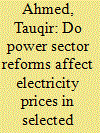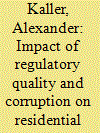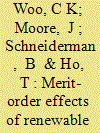|
|
|
Sort Order |
|
|
|
Items / Page
|
|
|
|
|
|
|
| Srl | Item |
| 1 |
ID:
091702


|
|
|
|
|
| Publication |
2009.
|
| Summary/Abstract |
Electricity demand in South Africa has grown at a very rapid rate over the past decade. As part of reform initiatives to enhance long-term sustainability of the country's electricity industry, South Africa's authorities have in recent years sought to develop an electricity pricing framework that is cost reflective and forms the cornerstone of demand management schemes meant to foster changes in consumption behaviour and enhance efficiency in resource use. The effects of any pricing policy on aggregate electricity consumption will depend on a useful understanding of the factors that influence electricity demand, and the magnitude to which electricity demand responds to changes in such factors. In this context, this paper applies the bounds testing approach to cointegration within an autoregressive distributed lag framework to examine the aggregate demand for electricity in South Africa during the period 1960-2007. The results indicate that in the long run, income is the main determinant of electricity demand. With electricity prices having an insignificant effect on aggregate electricity demand, future pricing policies will need to ensure that electricity prices are cost reflective and enhance efficiency of electricity supply and use.
|
|
|
|
|
|
|
|
|
|
|
|
|
|
|
|
| 2 |
ID:
111084


|
|
|
|
|
| Publication |
2012.
|
| Summary/Abstract |
How do policy actions affect the dynamics of deregulated electricity prices? We investigate this issue in the context of the Italian Power Exchange (IPEX), using data on the daily average day-ahead price (PUN) between April 2004 and December 2008.
Estimates of baseline time series models (SARMAX and SARMAX-EGARCH) and their forecasting performances suggest that the trend in natural gas prices, market power indicators, deterministic weekly patterns, perceived temperatures, persistence in conditional volatility, and the inverse leverage effect are essential features of the PUN dynamics. We then augment the best-performing models with dummies that account for changes in the market architecture, such as the introduction of contracts for differences (CfDs) to support renewables, trading of white certificates for energy efficiency, and the demand-side liberalization. The findings show that changes in the market architecture affected both the PUN level and its volatility. Specifically, wholesale electricity prices and volatility appear to have decreased upon the introduction of CfDs, only to be pushed upwards following the start of white certificates' trading and retail liberalization. Moreover, after controlling for reforms the inverse leverage effect vanishes, and the persistence in volatility is lower than in the baseline estimates.
|
|
|
|
|
|
|
|
|
|
|
|
|
|
|
|
| 3 |
ID:
162293


|
|
|
|
|
| Summary/Abstract |
The technical and financial influences that shape customer investment in behind-the-meter PV and battery systems, provide the means to forecast and quantify customer energy transitions. By utilising techno-economic scenario analysis, this research assists policymakers to understand the impacts of their decisions on future energy market relationships between the customer and utilities. Two case studies are presented, firstly to evaluate the influence of annual increases in usage charges, and secondly the level of feed-in tariff compensation on customer PV and battery investment over a 15-year forecast period located in Perth, Australia. The findings indicate that even without annual increases in usage charges, the falling installation costs of PV and battery technologies will make customer PV-battery systems financially viable within the 15-year forecast period. Additionally, the removal of the feed-in tariff leads to greater reductions in eventual grid consumption. By the end of the forecast period, customer PV-battery systems with the highest financial performance are able to reduce grid consumption above 90% resulting in significant energy resources being transferred out of the energy market. This necessitates the market integration of customer energy resources and provides an opportunity to leverage a combination of customer and utility energy resources for the renewable energy transition.
|
|
|
|
|
|
|
|
|
|
|
|
|
|
|
|
| 4 |
ID:
166482


|
|
|
|
|
| Summary/Abstract |
This paper examines the impact of power sector reforms on electricity prices using panel data for selected Asian countries over the period 1970–2017. We estimate two separate models for domestic and industrial prices. Our results from pooled OLS and the random effect model show that the impact of independent power producers, privatisation, restructuring, and deregulation on electricity prices is negative and significant, making both domestic and industrial consumers better off. However, the welfare effects of unbundling generation from transmission and distribution appear to be beneficial for residential end-users only. Our results also indicate that other reform indicators including third-party access and the existence of independent regulatory agencies may not be the right choice for a reduction in electricity prices, given the absence of a requisite conducive environment for regulations in our sample countries. Thus, the inconsistent behaviour of different regulatory reforms towards different countries and regions of the world needs to be considered in the policy formulation of the power sector. We also note that the results can be magnified in terms of significance with the exclusion of some outlier observations in the data.
|
|
|
|
|
|
|
|
|
|
|
|
|
|
|
|
| 5 |
ID:
111323


|
|
|
|
|
| Publication |
2012.
|
| Summary/Abstract |
There is an ongoing discussion if it is reasonable to start using nuclear energy, to extend its use, or what effects its phase out could have. In July 2011, four months after the nuclear accidents in Japan, Germany decided to return to the policy of phasing out nuclear energy step by step until 2022. This policy was already decided upon in 2000. With this, a decision made some nine months earlier was taken back. In fall 2010, the government and Parliament had approved the extension of the operating lives of its nuclear plants by at least 14 years. One reason was the expected effect on the electricity price, which was said to be lower with extended nuclear plant life spans.
However, there is an ongoing debate on this argument, not only in Germany. This article presents a critical survey of the core arguments brought forward in favour of expected future price cuts. It is shown that the theoretical electricity market models used in these exercises are not adequate to reliably predict such effects. Furthermore, evidence is presented suggesting that extending nuclear plant life spans or the commissioning of new reactors in other countries is unlikely to curb domestic electricity prices.
|
|
|
|
|
|
|
|
|
|
|
|
|
|
|
|
| 6 |
ID:
125519


|
|
|
|
|
| Publication |
2013.
|
| Summary/Abstract |
In this paper, we use a panel of the 48 contiguous US states over the period 1970-2009 to examine the dynamics of electricity demand in addressing the four hypotheses set forth in the literature: growth, conservation, neutrality, and feedback. In doing so we provide both short-run and long-run elasticity estimates for electricity demand. Recent developments in nonstationary panel estimation techniques allow for heterogeneity in the coefficients while examining the direction of causality among electricity consumption, electricity prices, and income growth. In addition to the full sample, we also disaggregate the sample into three sectors: commercial, industrial, and residential. The short-run results provide evidence in favor of the growth hypothesis for the aggregate sample, as well as for the industrial sector. For the residential and commercial sectors, the conservation hypothesis is supported. Long-run results favor the conservation hypothesis. To ascertain differences in electricity demand relating to electricity intensity we also examine states based on their efficiency in electricity consumption. Overall, the results yield in favor of the growth hypothesis for low intensity states and conservation hypothesis for high intensity states.
|
|
|
|
|
|
|
|
|
|
|
|
|
|
|
|
| 7 |
ID:
176853


|
|
|
|
|
| Summary/Abstract |
In this paper, we estimate volatility spillovers before and after the introduction of a new cable linking different electricity market zones. Using wholesale electricity prices for Sardinia and two neighbouring Italian market zones for the period 2005–2015, we focus on the effects of the SAPEI cable, fully operational since March 2011. VAR-GARCH estimates indicate that the SAPEI cable allowed for stronger volatility transmission towards Sardinia, a smaller zone and a net importer from its new neighbour, the Central Southern zone, albeit the effect was significant only off-peak. Higher conditional correlations between zonal prices are also observed after the cable was introduced. Some implications are drawn about the interaction between market size, export positions, congestion, and volatility transmission.
|
|
|
|
|
|
|
|
|
|
|
|
|
|
|
|
| 8 |
ID:
126539


|
|
|
|
|
| Publication |
2013.
|
| Summary/Abstract |
Various electricity reforms have been adopted by a number of countries within the last 2 decades. Turkey, as one of those countries, has restructured its electricity market and intensively privatized the distribution companies. As one of the main targets of the liberalization efforts in the sector was announced to be reduced consumer prices, it is a matter of interest to look at the related developments after privatizations. Hence, this study attempts to explore the impact of power distribution privatization in Turkey on the national end-user electricity prices. Results of the analysis suggest that privatization of electricity distribution companies has not yielded the expected retail price declines within the first 4 years of the program. Whereas wholesale tariffs exhibit a reduction in the rate of 10%, retail tariffs show an increase of 5.9% within the period in question. Besides, the unstable patterns of the two tariffs imply that the market is not yet ready for the automatic pricing mechanism planned to be implemented based on a cost-reflective methodology. Therefore, results indicate that the factors behind the unsatisfactory outcomes of the program should be explored in order for the privatization efforts in the Turkish electricity distribution market to serve the purpose.
|
|
|
|
|
|
|
|
|
|
|
|
|
|
|
|
| 9 |
ID:
166481


|
|
|
|
|
| Summary/Abstract |
Electricity market models are widely employed to study the role, impacts and economic viability of new technologies. Sources of arbitrage, such as storage and transmission, are increasingly seen as essential for integrating higher shares of variable renewables. Understanding their operation and business case requires models which accurately represent time-series of wholesale electricity prices.
|
|
|
|
|
|
|
|
|
|
|
|
|
|
|
|
| 10 |
ID:
163569


|
|
|
|
|
| Summary/Abstract |
This paper provides estimates of quantile regression models of the relationship between Italian day-ahead electricity prices, the supply of renewables and the inception of a new cable (SAPEI, linking Sardinia with the Italian peninsula), in the 2006–2015 time window. The results confirm the merit order effects detected in the existing literature, both for photovoltaics and wind power, more strongly in market conditions characterised by moderately low price levels and with some implied increase in volatility. The new cable has apparently challenged the ability of power generating companies to extract value through price spikes, has mitigated volatility, and its effects have been complementary with those of renewables. Effects from photovoltaics are more sensitive to robustness checks. Differences across zonal markets are nonetheless detected.
|
|
|
|
|
|
|
|
|
|
|
|
|
|
|
|
| 11 |
ID:
166724


|
|
|
|
|
| Summary/Abstract |
The price of electricity for European end users typically fell until development of wind and solar energy began, but has increased since then. We estimate the savings in CO2 emissions due to solar and wind energy and calculate what end users pay per tonne CO2, assuming that price increases since the introduction of solar and wind power are due to these types of energy. These payments are in most cases well above even high and unlikely estimates of the cost of carbon and in some cases several times as high.
|
|
|
|
|
|
|
|
|
|
|
|
|
|
|
|
| 12 |
ID:
103366


|
|
|
|
|
| Publication |
2011.
|
| Summary/Abstract |
One of the main expectations from power market reform has been a reduction in both price-cost margins and cross-subsidy levels between industrial and residential consumers. This paper focuses on this issue by looking at the impact of the electricity industry reforms on residential and industrial electricity price-cost margins and their effect on cross-subsidy levels between consumer groups. Using panel data for 63 developed and developing countries covering the period 1982-2009, empirical models are developed and analyzed. The research findings suggest that there is no uniform pattern for the impact of reform process as a whole on price-cost margins and cross-subsidy levels. Each individual reform step has different impact on price-cost margins and cross-subsidy levels for each consumer and country group. Our findings imply that reform steps have different impacts in different countries, which supports the idea reform prescription for a specific country cannot easily and successfully be transferred to another one. So, transferring the formal and economic structure of a successful power market in a developed country to developing countries is not a sufficient condition for good economic performance of the electricity industries in developing countries. Furthermore, the study suggests that power consumption, income level and country-specific features constitute other important determinants of electricity price-cost margins and cross-subsidy levels.
|
|
|
|
|
|
|
|
|
|
|
|
|
|
|
|
| 13 |
ID:
162288


|
|
|
|
|
| Summary/Abstract |
The European electricity markets have been undergoing significant regulatory reforms since the introduction of the first liberalisation directive in 1996. Theory predicts that liberalisation promotes cost-efficient production and competition and hence leads to lower prices. The goal of this paper is to assess the impact of regulatory quality and non-compliance with the law on electricity prices in the context of electricity market reforms. We address problems of endogeneity by using the Blundell-Blond System GMM estimator and find that vertical integration and market concentration lower end-user prices, all else equal. Moreover, improving regulatory quality and reducing corruption, both have a negative impact on prices when holding other factors constant. The intensity of the reforms has limited impact on electricity prices when these reforms are introduced in an institutional environment characterised by high levels of corruption and low quality regulation.
|
|
|
|
|
|
|
|
|
|
|
|
|
|
|
|
| 14 |
ID:
175895


|
|
|
|
|
| Summary/Abstract |
This paper analyses the current state of electricity prices for large industrial consumers in Spain and compares the regulatory framework with other main industrial countries in Europe. The cost of electrical energy is a key factor in a country's industrial competitiveness. In a regulatory context shaped by the new European regulation of the internal electricity market in Europe, it would be expected that electricity prices in the Member States will converge in the long term, reaching similar values throughout the European Union. However, the limited electricity interconnection capacity in the case of some countries, such as Spain, means that electricity market prices are higher than in many Member States. This means that electricity-consuming industries face problems of competitiveness due to their higher energy bill costs. This paper focuses on the current situation for large industrial consumers in Spain, studying the main causes of the differences with other European countries, as well as analysing the various support mechanisms that have been implemented at both the national and European levels. This study also discusses the future prospects and possible solutions and recommendations for energy policy to promote the competitiveness of large industry in Spain within the context of a single European market.
|
|
|
|
|
|
|
|
|
|
|
|
|
|
|
|
| 15 |
ID:
136237


|
|
|
|
|
| Summary/Abstract |
Germany continues to play a pioneering role in replacing conventional power plants with renewable energy sources. While this might be beneficial with respect to environmental quality, it also implies increasing electricity prices. The extent to which this is associated with negative impacts on employment depends on the interrelationship between labor and electricity as input factors in the production process. In this paper, we estimate cross-price elasticities between electricity and heterogeneous labor for the German manufacturing sector. We use administrative linked employer–employee micro-data combined with information on sector-level electricity prices and usage over the period 2003–2007. We find positive, but small conditional cross-price elasticities of labor demand with respect to electricity prices, which means that electricity as an input factor can be replaced by labor to a limited extent when the production level is held constant. In the case of adjustable output, we find negative unconditional cross-price elasticities, implying that higher electricity prices lead to output reductions and to lower labor demand, with low- and high-skilled workers being affected more than medium-skilled. Resulting adverse distributional effects and potential overall job losses may pose challenges for policy-makers in securing public support for the German energy turnaround.
|
|
|
|
|
|
|
|
|
|
|
|
|
|
|
|
| 16 |
ID:
111391


|
|
|
|
|
| Publication |
2012.
|
| Summary/Abstract |
The integration of large-scale wind power has brought about a series of challenges to the power industry, but at the same time a number of benefits are being realized. Among those, the ability of wind power to cause a decline in the electricity market prices has been recognized. In quantifying this effect, some models used in recent years are based on simulations of the market supply-side and the price clearing process. The accuracy of the estimates depend on the quality of the input data, the veracity of the adopted scenarios and the rigorousness of the solution technique. In this work, a series of econometric techniques based on actual ex post wind power and electricity price data are implemented for the estimation of the impact of region-wide wind power integration on the local electricity market clearing prices and the trading savings that stem from this effect. The model is applied to the case of Spain, where the estimated savings are compared against actual credit and bonus expenses to ratepayers. The implications and extent of these results for current and future renewable energy policy-making are discussed.
|
|
|
|
|
|
|
|
|
|
|
|
|
|
|
|
| 17 |
ID:
115648


|
|
|
|
|
| Publication |
2012.
|
| Summary/Abstract |
With the ongoing development of Australian anthropogenic climate change mitigation policies, there has been a steady increase in modelling studies undertaken to estimate Australian carbon prices and their impact on existing electricity markets. This article summarises some of the more prominent studies completed by many of Australia's foremost economic modelling firms. We developed a simple approach for testing the consistency of these studies and their findings in relation to carbon pass-through. Unfortunately, we have established that the studies are entirely inconsistent in their estimation of carbon pass-through. Furthermore, we were unable to establish why the estimation of carbon pass-through varies so significantly. This has important implications for policy makers given much of the compensation to be paid to households and businesses under the Clean Energy Future package is predicated on simple assumptions of carbon pass-through. Based upon our analysis of these economic studies, our conclusion is that Australian policy makers are best guided by relying upon the numerous a posteriori estimations of pass-through in the European Union Emissions Trading Scheme (ETS) rather than Australian a priori studies.
|
|
|
|
|
|
|
|
|
|
|
|
|
|
|
|
| 18 |
ID:
150907


|
|
|
|
|
| Summary/Abstract |
Monthly and hourly correlations among photovoltaic (PV) capacity utilization, electricity prices, electricity consumption, and the thermal efficiency of power plants in Massachusetts reduce electricity prices and carbon emissions beyond average calculations. PV utilization rates are highest when the thermal efficiencies of natural gas fired power plants are lowest, which reduces emissions of CO2 and CH4 by 0.3% relative to the annual average emission rate. There is a positive correlation between PV utilization rates and electricity prices, which raises the implied price of PV electricity by up to 10% relative to the annual average price, such that the average MWh reduces electricity prices by $0.26–$1.86 per MWh. These price reductions save Massachusetts rate-payers $184 million between 2010 and 2012. The current and net present values of these savings are greater than the cost of solar renewable energy credits which is the policy instrument that is used to accelerate the installation of PV capacity. Together, these results suggest that rooftop PV is an economically viable source of power in Massachusetts even though it has not reached socket parity.
|
|
|
|
|
|
|
|
|
|
|
|
|
|
|
|
| 19 |
ID:
150438


|
|
|
|
|
| Summary/Abstract |
We answer two policy questions: (1) what are the estimated merit-order effects of renewable energy in the California Independent System Operator’s (CAISO’s) day-ahead market (DAM) and real-time market (RTM)? and (2) what causes the hourly DAM and RTM prices to systematically diverge? The first question is timely and relevant because if the merit-order effect estimates are small, California’s renewable energy development is of limited help in cutting electricity consumers’ bills but also has a lesser adverse impact on the state’s investment incentive for natural-gas-fired generation. The second question is related to the efficient market hypothesis under which the hourly RTM and DAM prices tend to converge. Using a sample of about 21,000 hourly observations of CAISO market prices and their fundamental drivers during 12/12/2012–04/30/2015, we document statistically significant estimates (p-value≤0.01) for the DAM and RTM merit-order effects. This finding lends support to California’s adopted procurement process to provide sufficient investment incentives for natural-gas-fired generation. We document that the RTM-DAM price divergence partly depends on the CASIO’s day-ahead forecast errors for system loads and renewable energy. This finding suggests that improving the performance of the CAISO’s day-ahead forecasts can enhance trading efficiency in California’s DAM and RTM electricity markets.
|
|
|
|
|
|
|
|
|
|
|
|
|
|
|
|
| 20 |
ID:
186440


|
|
|
|
|
| Summary/Abstract |
Global climate targets have highlighted the need for a whole-systems approach to decarbonisation, one that includes targeted national policy and industry specific change. Situated within this context, this research examines policy and pricing barriers to decarbonisation of the UK steel industry. Here the techno-economic modelling of UK green steelmaking provides a technical contribution to analysis of pricing barriers and policy solutions to these barriers in the UK specifically, but also to the broader industrial decarbonisation literature. Estimated costs and associated emissions projections reveal relevant opportunities for UK steel in contributing to national climate and emissions targets. Modelling demonstrates that green steelmaking options have been put at price disadvantages compared to emissions-intensive incumbents and that fossil-free hydrogen-based steelmaking has lower emissions and lower levelised costs than carbon capture and storage options, including top gas recycling blast furnace (TGR-BF) with CCS, and HIsarna smelter with CCS. Two primary policy recommendations are made: the removal of carbon pricing discrepancies and reductions in industrial electricity prices that would level the playing field for green steel producers in the UK. The research also provides relevant policy considerations for the international community in other industrial decarbonisation efforts and the policies that must accompany these decarbonisation choices.
|
|
|
|
|
|
|
|
|
|
|
|
|
|
|
|
|
|
|
|
|